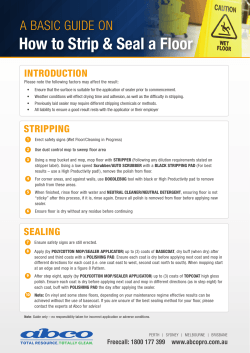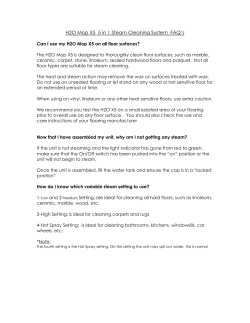
Installation & Cleaning Instructions How to install, cut and finish and
Installation & Cleaning Instructions How to install, cut and finish and maintain your ecotile floor. INTRODUCTION ecotile can be installed over any hard surface and in most situations will not require gluing. The only situations where we recommend gluing are where the tiles will be located in direct sunlight (i.e. south facing loading bay) or there will be very heavy traffic movements combined with tight turning circles. Installation should not take place at temperatures below 15ºC if at all possible, contact our technical department for advice. The tiles must be allowed to acclimatize for a minimum of 24 hours to the ambient room temperature prior to installation. A 5mm expansion gap must be left between the tiles and any fixed point (walls and machinery) to allow expansion and contraction of the tiles when changes in temperature occur. If the area where installation is taking place is likely to experience large fluctuations in temperature it is advised that the tiles are cut around racking, heavy machinery etc. to allow free movement of the tiles. PREPARATION: Sweep or vacuum the floor to remove any loose impediments Remove any high points in the floor Fill any holes with a rapid setting floor repair compound such as Ardurapid A46 or similar For uneven surfaces that require smoothing use a smoothing compound such as Ardex Feather Finish. CUTTING THE TILES ecotile can be cut using several methods, a lot will depend on personal preference, experience and the tools you have on hand but we recommend the following: Magnum shear / guillotine – Available to hire from Versatile Stanley / utility knife with a concave blade – Always use a straight edge and wear cut proof gloves. Electric jig saw with a medium or rough wood blade Table saw or Band saw with a medium or rough wood blade Magnum Guillotine Electric Jigsaw Stanley knife with concave blade ecotile 6, 7 and 10mm interlocking floor tiles: Start installation of the tiles from the middle of the room, working outward towards the sides. This will ensure even distribution of the weight and surface tension of the tiles. Measure to find the centre of the room and lay a chalk line along both the length and width of the room to identify your starting point and to ensure that the tiles are fitted at 90 degrees to each other. It is very important to lay the first row straight; this will affect the entire installation. Using the rubber mallet, tap tiles together, starting at the corner & working your way out to each edge. Use a rubber mallet or engineering hammer to join the tiles. Work out in a circular pattern from the centre of the room filling in the corners as you move outwards. Once all the full tiles have been installed allow the floor to settle for a few hours before fitting the cut sections of the tiles up to walls and around fixed machinery and equipment ensuring that you allow at least a 5mm expansion gap. Installation Pattern Chalk Line to mark centre of the room . ecotile esd installation: Install the ecotile esd tiles using the same method as the standard tiles but to achieve a fully grounded floor follow the following earthing guidelines. The tiles can be used by themselves to provide a static dissipative floor or in conjunction with grounding kits to make the floor conductive. To achieve a conductive floor surface lay the black Velostat tape underneath tiles at 2m intervals with as per image esd 1. It is recommended that you have one earthing point per 80 to 100m² of Ecotile ESD and / or one earthing point for each separate room or section of ESD. USEFUL HINT: Use double sided tape to stick each end of the tape strip to the floor to stop it moving. Once you have formed the grid you can start laying the tiles. Starting from the centre of the room lay the first four tiles in a square ensuring that the interlocking joints are centred on the Velostat strip (i.e. all 4 tiles are in contact with the Velostat) Work outwards from the centre being careful to ensure that the interlocking joints stay in contact with the Velostat conductive strip. ESD Grounding: image esd 1 Finishing and Edges: When all full size tiles are laid it is advisable to wait 24hrs before cutting the edge sections. This will allow the tiles to settle and expand fully. Remember to leave a 5mm expansion gap between the tiles and any fixed points (walls, machines etc.) To get the best results when cutting use a table saw, guillotine or jigsaw. We recommend finishing the 5 mm expansion gap between the tiles and the walls with a sit on skirting profile such as Gradus SO100. Wood doorjambs can be undercut so the tile can slip underneath. With metal doorjambs – cut the flooring material to within 5mm & then caulk around the jamb. Ramp and corner sections are available to finish your floor. Sit on skirting Ramp and corner sections Cleaning & General Maintenance: By following these simple instructions you will help ensure that your floor looks good, maintains its anti-slip performance and you will also help extend its life span. 1. 2. 3. 4. 5. Sweep or vacuum the floor to remove dust and dirt as often as is practical. If available use a rotary scrubber dryer, if not a two compartment (separate clean & dirty water) bucket and mop. Use clean water and a neutral pH floor cleaner in a weak solution. Optional Non- ESD Floors - Apply two to three coats of a hard wearing floor sealer when the floor is new. ESD / Anti-static Floors - Apply two to three coats of Selstat anti-static floor polish to enhance performance and durability. Cleaning Chemicals & Polishes Heavy Duty Cleaning, Degreasing & Stripping of polish: A powerful heavy duty cleaning and degreasing concentrate that removes multiple coats of dirt, oil, grease and finish build-up. Ideal for factories and industrial applications Viper Heavy Duty Floor stripper - Box of 4 x 4ltrs - £124.00 + VAT General Day to Day General Cleaning: Clean the floor with ROTEX a one-step, neutral cleaner designed to quickly remove embedded soils without any residue. ROTEX requires no rinsing, and leaves a peach fragrance. Ideal for use with auto-scrubbers or the Biomop system. Code: Rotex Floor Cleaner - Box of 4 x 4ltrs - £59.50 + VAT Floor Sealer / Polish: To create a high quality finish and help reduce maintenance of your floor we recommend applying two to three coats or a good quality floor sealer. DISTANCE is a clear, high gloss, hard, thermacrylic floor finish with superior dirt and black mark resistance. Coverage 50m² per litre / per coat –Distance Floor Sealer - Box of 4 x 4ltrs - £119.50 + VAT ESD / Anti-Static Polish & Cleaner: Retains performance even at humidity as low as 11%. Independently tested to IEC 61340 - 4 – 1 and BS 7506. Improves the conductivity of conductive ESD flooring. Applies, hardens and protects like a normal floor polish. For cleaning dilute polish 40 parts clean water to 1 part polish and mop or rotary scrubber dry. Coverage 500 sq m with 2 coats (Polish also used for cleaning) - Selstat Anti-Static Floor Polish- Box of 4 x 5ltrs - £149.50 + VAT Dr. Schutz Floor Mate Recommended for removing trainer scuff marks and spot cleaning ecotile. Dr Schutz Floor Mate- 400ml bottle£9.75 per bottle + VAT Cleaning Equipment Rotary Scrubber Dryer - Cleaning the floor with a rotary scrubber dryer is the quickest and simplest method. If possible use a machine which has twin roller brushes and a powerful vacuum to suck up the dirty water. Investment in a good quality rotary scrubber dryer will save time, reduce cost by saving on labour and keep your floor looking good and performing well. Equipment Recommendation Karcher BR 45/40C - £2650.00 + VAT Biomop System - Consisting of a mop with a micro fibre mop head and twin compartment bucket. The micro fibre mop head lifts dirt from the surface of the floor and the two compartment buckets ensure that your clean and dirty water remain separate. This damp mopping system leaves the floor clean and semi-dry ready for foot traffic. The biomop system is ideal for smaller installations or where the floor area is difficult to access. Twin Compartment Bucket, Mop head, handle and 5 Microfibre Mop heads - £89.50 + VAT How to maintain your ecotile floor: Keeping your floor clean and looking good is a simple task but will involve a small investment on your part in the correct equipment and chemicals and the introduction of a simple but professional cleaning regime. The cleaning regime will be dictated by the usage that your floor will experience and can be broken down into three categories as follows: 1. Preventive Measures - In entrance areas it is essential to install a large, effective dirt and moisture collection entrance mat which must be cleaned or replaced at regular intervals. This prevents a large percentage of dirt being carried into the building and diminishes wear and tear strain on the floor. Chairs fitted with either defective or missing gliders or unsuitable rollers/wheels destroy both the surface protection and the floor coverings themselves and should be changed or replaced. 2. Initial Clean/Re-sealing the floor - The floor must be thoroughly cleaned prior to applying the sealer in order to remove installation-related residues and building dirt from newly installed floors, to remove any possible existing care finish and to get rid of residues of care products and dirt in the case of older floorings. Apply Rotex diluted with water (mix ratio is dependent on the resistance of the dirt residues). After allowing it to stand for 10-15 minutes, scrub the floor using a floor scrubber/polisher fitted with green pad. Rinse the floor with clean, if possible warm, water until all traces of dirt and cleaning agents have been completely removed (the mopping water no longer bears any traces of foam!). 3. Surface Protection - To protect the floor, help routine cleaning and prolong the lifespan of the flooring, a protective film of sealer can be applied immediately after completion of the cleaning. Distance is a long-term sealer, is particularly durable and will help improve the anti-slip performance of the floor. 3.1 Initial Treatment: After cleaning with a rotary scrubber dryer, apply one to two / three coats of the sealer evenly to the dry floor with a mop if using the general purpose sealer or a short pile roller (10 mm) if using the heavy duty sealer. Between applications wait for the previous film to dry and become firm enough to walk on but apply both coats on the same day. 3.2 Repair and Renewal: Depending on the level of use and usage conditions, the sealer film should be checked at regular intervals for signs of wear and tear and a renewed sealer operation performed if required. For this purpose, after thoroughly removing dirt and other residues apply sealer to the dry floor. It is possible to carry out repair and renewals of individual warn areas of sealer. Note: Before applying sealer remove the shine from the floor surface using the floor scrubber and green pad to guarantee an optimum adhesion of the following sealer coat. Freshly sealed floors can be walked on after 4 hours if the general purpose sealer has been used and 24 hours if the heavy duty sealer has been used. 4. Maintenance of ecotile ESD / Anti-static Floor Tiles - VERY IMPORTANT - We recommend applying two coats of Selstat anti-static floor sealer to ecotile ESD Floor tiles when first installed to improve and help maintain the conductivity of ESD tiles. Selstat once applied, hardens and protects the floor and helps maintain an anti-slip finish. Selstat must be applied to a clean grease free floor. Apply a thin even film of Selstat using a clean lint free mop or applicator. Apply a second coat when the first is dry (approximately 30 minutes). COVERAGE: 60 square metres per litre. 4.1 Use a dedicated set of cleaning equipment for the ESD floor - Do not use equipment that has been used on other floor types or areas of the building where it may have come in contact with strong acid or alkaline cleaners. This could damage the ESD performance of your floor. WE STRONGLY RECOMMEND USING ROTEX NEUTRAL PH FLOOR CLEANER FOR MAINTAINING ECOTILE ESD FLOORING. USE OF ANY OTHER PRODUCTS MAY INVALIDATE YOUR WARRANTY. 4.2 Dust Removal: It is essential to prevent a layer of insulative dust building up on the ESD floor which may restrict the ESD performance of the surface. Remove loose surface dust and dirt by sweeping, vacuum or wiping over the floor with a slightly damp mop. 4.3 Manual or Mechanical Wet Cleaning: To remove dirt adhering to the floor dilute 1:10 Selstat polish with clean water using the wet mopping method, clean the floor with a suitable mop (e.g. Biomop) or using a cleaning appliance (e.g. rotary scrubber/dryer). 4.4 Intermediate Cleaning: In cases where it is no longer possible to remove dirt adhering to the floor surface by wet mopping, perform an intermediate cleaning operation with detergent in a dilution with water appropriate to the level of dirt present (e.g. 1.50 to 1:100). Regular polishing up of the floor after cleaning with floor polisher with a white pad is recommended for optimum maintenance of floor condition and to facilitate cleaning. 5. Routine Cleaning and Care 5.1 Dust Removal: Loose surface dust and dirt is removed by sweeping, vacuum or wiping over the floor with a slightly damp mop, we recommend the Unger Biomop system. 5.2 Manual or Mechanical Wet Cleaning: To remove dirt adhering to the floor dilute detergent in a ratio of 1:200 and, using the wet mopping method, clean the floor with a suitable mop (e.g. Biomop) or using a cleaning appliance (e.g. rotary scrubber/dryer). 5.3 Intermediate Cleaning: In cases where it is no longer possible to remove dirt adhering to the floor surface by wet mopping, perform an intermediate cleaning operation with detergent in a dilution with water appropriate to the level of dirt present (e.g. 1.50 to 1:100). Regular polishing up of the floor after cleaning with floor polisher with a white pad is recommended for optimum . 6. Removal of Stains and Rubber Heel Marks - Stubborn stains and rubber heel marks can be removed using undiluted PU-Cleaner together with a cloth or nonabrasive white pad. Subsequently wipe over the area with clear water. Remove stains immediately if possible since certain types of stains settle into the flooring as they age and can then only be removed with difficulty or are impossible to remove completely. PLEASE REMEMBER THE FOLLOWING RULES Regular & light cleaning is better than infrequent and heavy cleaning Do use an entrance mat to remove as much dirt and moisture. Do use a neutral PH floor cleaning detergent Don’t use an excessive concentration of cleaning detergent, it will leave a sticky residue on the floor making cleaning harder in the future. Do use the correct cleaning equipment, either a two component bucket and mop system or rotary scrubber dryer, it may cost a bit more up front but will save you a fortune in time and effort in the long run. Don’t use excessive amounts of water, this will make your job harder, not easier, damp mopping is the best solution. For floors with high levels of pedestrian traffic seal the floor with a hard wearing floor polish, it will help with cleaning and extend the durability of the finish.
© Copyright 2025









